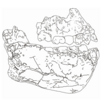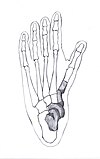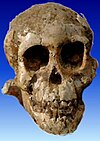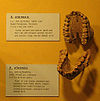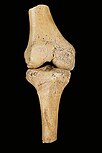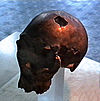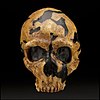List of human evolution fossils
| Part of a series on |
| Paleontology |
|---|
 |
|
Paleontology Portal Category |
The following tables give an overview of notable finds of hominin fossils and remains relating to human evolution, beginning with the formation of the tribe Hominini (the divergence of the human and chimpanzee lineages) in the late Miocene, roughly 7 to 8 million years ago.
As there are thousands of fossils, mostly fragmentary, often consisting of single bones or isolated teeth with complete skulls and skeletons rare, this overview is not complete, but shows some of the most important findings. The fossils are arranged by approximate age as determined by radiometric dating and/or incremental dating and the species name represents current consensus; if there is no clear scientific consensus the other possible classifications are indicated.
The early fossils shown are not considered ancestors to
Late Miocene (7.2–5.5 million years old)
The chimpanzee–human divergence likely took place during around 10 to 7 million years ago.[1] The list of fossils begins with Graecopithecus, dated some 7.2 million years ago, which may or may not still be ancestral to both the human and the chimpanzee lineage. For the earlier history of the human lineage, see Timeline of human evolution#Hominidae, Hominidae#Phylogeny.
| Image | Name | Age ( Ma )
|
Species | Year discovered |
Country | Discovered by | Now located at |
|---|---|---|---|---|---|---|---|
 |
El Graeco | 7.20[2] | Graecopithecus | 1944, 2017 | Greece, Bulgaria Site:Pyrgos Vassilissis, Azmaka |
Böhme (Tübingen), Spassov (BAS) | Met, Athens; Tübingen, Germany |

|
TM 266 (Toumai) | 7.00–6.00[3] | Sahelanthropus tchadensis | 2001 | Chad Site:Djurab Desert |
Michel Brunet, Alain Beauvilain, Fanone Gongdibe, Mahamat Adoum and Ahounta Djimdoumalbaye | N'Djamena (Chad), BEAC |
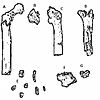
|
BAR 1000'00 | 6.1–5.7[4] | Orrorin tugenensis | 2000 | Kenya Site:Lukeino |
Martin Pickford, Kiptalam Cheboi, Dominique Gommery, Pierre Mein, Brigitte Senut | |

|
Trachilos footprints | 6.05[5] | Made by hominin or hominin-like primate | 2002 | Greece | Gerard D. Gierliński | |

|
ALA-VP 1/20[6] | 5.65±0.150 | Ardipithecus kadabba | 1997 | Ethiopia Site:Middle Awash |
Yohannes Haile-Selassie |
Pliocene (5.3–2.58 million years old)
Pleistocene
Lower Paleolithic: 2.58–0.3 million years old
| Name | Age ( Ma )
|
Species | Date discovered |
Country | Discovered by | Now located at | |
|---|---|---|---|---|---|---|---|

|
KNM-WT 17000
(The Black Skull) |
2.50 | Paranthropus aethiopicus | 1985 | Kenya | Alan Walker | |
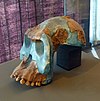
|
BOU-VP-12/130[24] | 2.50 | Australopithecus garhi | 1997 | Ethiopia | Yohannes Haile-Selassie | |

|
STS 71[25] | 2.61–2.07 | Australopithecus africanus | 1947 | Sterkfontein, South Africa | John T. Robinson
|
Ditsong National Museum of Natural History |

|
STS 52 | 2.61–2.07 | Australopithecus africanus | 1947 | Sterkfontein, South Africa | Robert Broom | Ditsong National Museum of Natural History |
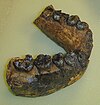
|
UR 501 (Uraha jawbone)
|
2.40±0.10 | Homo rudolfensis[26] | 1991 | Malawi | Tyson Msiska, Timothy Bromage, Friedemann Schrenk | |

|
STS 5 (Mrs. Ples) (STS 14)[27] |
2.07[28] | Australopithecus africanus | 1947 | Sterkfontein, South Africa | Robert Broom | Ditsong National Museum of Natural History |
DNH 134 (Simon)[29]
|
2.04[29] | Homo erectus | 2015 | Drimolen Main Quarry, South Africa | Andy Herries' team (excavated by Richard Curtis, Andy Herries, Angeline Leece; reconstructed by Jesse Martin) | University of the Witwatersrand | |
| DNH 155[30] | 2.04–1.95 | Paranthropus robustus | 2018 | Drimolen Main Quarry, South Africa | Andy Herries and Stephanie Baker's team (first found by Samantha Good and excavated by Samantha Good, Angeline Leece, Stephanie Baker and Andy Herries; reconstructed by Jesse Martin) | University of the Witwatersrand | |
| DNH 152[29](Khethi) | 2.04–1.95[29] | Paranthropus robustus | 2018 | Drimolen Main Quarry, South Africa | Andy Herries and Stephanie Baker's team (first part found by Khethi Nkosi. later parts by Amber Jaeger, Eunice Lalunio; reconstructed by Jesse Martin & Angeline Leece) | University of the Witwatersrand | |
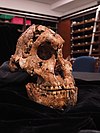
|
DNH 7
(Eurydice)[31] |
2.04–1.95[29] | Paranthropus robustus | 1994 | Drimolen, Drimolen Main Quarry, South Africa | R. Smith and André Keyser
|
University of the Witwatersrand |
| KNM-ER 64060 | 2.03 | Homo habilis | 2012 | Ileret, Kenya | |||
| KNM-ER 64061 | 2.02 | Homo erectus | 2012-2013 | Ileret, Kenya | |||

|
TM 1517[32] | 2.0 | Paranthropus robustus | 1938 | South Africa | Gert Terblanche | Ditsong National Museum of Natural History |

|
MH1 (Karabo)[33][34] | 1.98[35] | Australopithecus sediba | 2008 | Malapa, South Africa | Matthew Berger and Lee Rogers Berger
|
University of the Witwatersrand |
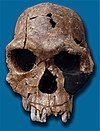
|
KNM-ER 1813 | 1.90 | Homo habilis | 1973 | Kenya | Kamoya Kimeu | |
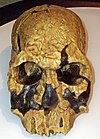
|
KNM-ER 1470
|
1.90 | Homo rudolfensis | 1972 | Kenya | Bernard Ngeneo[36] | |

|
SK 48 | 2.25–1.80 | Paranthropus robustus | 1948 | Swartkrans, South Africa | Robert Broom | Ditsong National Museum of Natural History |
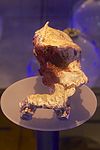
|
SK 46[37] | 2.25–1.80 | Paranthropus robustus | 1949 | Swartkrans, South Africa | Robert Broom | Ditsong National Museum of Natural History |

|
SK 847[38] | 2.25–1.80 | Homo habilis | 1949 | Swartkrans, South Africa | Ditsong National Museum of Natural History | |

|
OH 24 (Twiggy)[39] |
1.80 | Homo habilis | 1968 | Tanzania | Peter Nzube | |

|
OH 8[40] | 1.80 | Homo habilis | 1960 | Olduvai, Tanzania | ||

|
Dmanisi Skull 3 )
|
1.81±0.40[41] | Homo erectus | 2001 | Dmanisi, Georgia | David Lordkipanidze and Abesalom Vekua | |

|
Dmanisi Skull 4 )
|
1.81±0.40 | Homo erectus | 2003 | Dmanisi, Georgia | David Lordkipanidze | |

|
Dmanisi Skull 5 )
|
1.81±0.40 | Homo erectus | 2005 (published in 2013) | Dmanisi, Georgia | David Lordkipanidze | |
| KNM-ER 62000–62003[42] | 1.84±0.60 | Homo rudolfensis | 2012 | Koobi Fora, Kenya | Meave Leakey's team | ||
| KNM-ER 64062 | 1.84±0.02 | Homo erectus | 2013 | Ileret, Kenya | |||

|
OH 5
(Zinj or nutcracker man) |
1.75 | Paranthropus boisei | 1959 | Tanzania | Mary Leakey | |
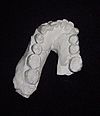
|
OH 7 | 1.75 | Homo habilis | 1960 | Tanzania | Jonathan Leakey | |
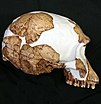
|
StW 53 | 1.8–1.6[28] | variously A. africanus, H. habilis, H. gautengensis | 1976 | Sterkfontein, South Africa | A. R. Hughes | University of the Witwatersrand |

|
KNM-ER 1805 | 1.74 | Homo habilis | 1973/4 | Kenya | Paul Abell | |

|
Yuanmou Man | 1.70 or 0.60–0.50 (disputed)[43] |
Homo erectus | 1965 | China | Fang Qian | |

|
KNM-ER 406 | 1.70 | Paranthropus boisei | 1969 | Kenya | Richard Leakey | |

|
KNM-ER 732[44] | 1.70 | Paranthropus boisei | 1970 | Kenya | Richard Leakey | |

|
KNM-ER 23000[45] | 1.70 | Paranthropus boisei | 1990 | Koobi Fora, Kenya | Benson Kyongo | |
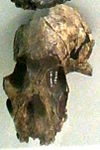
|
KNM-WT 17400[46][47] | 1.70 | Paranthropus boisei | Not known[48] | Lake Turkana (West Lake Turkana) Kenya | unknown[48] | National Museums of Kenya, Nairobi (Kenia) |
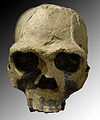
|
KNM-ER 3733
|
1.63±0.15[49] | Homo ergaster (a.k.a. African Homo erectus) | 1975 | Kenya | ||
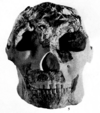
|
Lantian Man | 1.62±0.03 | Homo erectus | 1963 | Lantian County, China | Woo Ju-Kang | |

|
KNM-WT 15000 (Turkana Boy) |
1.60 | Homo ergaster (a.k.a. African Homo erectus) | 1984 | Lake Turkana (West Lake Turkana), Kenya | Kamoya Kimeu | Kenya National Museum |

|
Peninj Mandible | 1.50 | Paranthropus boisei | 1964 | Tanzania | Richard Leakey | |

|
Ileret Footprints | 1.50 | Homo erectus | 2007-2014 | Ileret, Kenya | ||

|
KNM-ER 992 | 1.50 | Homo ergaster (a.k.a. African Homo erectus) | 1971 | Kenya | Richard Leakey | |

|
KNM-ER 3883
|
1.57±0.08 | Homo erectus | 1976 | Kenya | Richard Leakey | |

|
Mojokerto 1 (Mojokerto child) |
1.43±0.10 | Homo erectus | 1936 | Indonesia | Andojo, G.H.R. von Koenigswald
|
|
 |
BL02-J54-100[50]
|
1.40 | Similar to H. heidelbergensis
|
Unknown | Spain | Unknown | |
| KGA 10-525[51][52] | 1.40 | Paranthropus boisei | 1993 | Konso-Gardula, Ethiopia | A. Amzaye | ||

|
OH 9
(Chellean Man)[53] |
1.40 | Homo erectus | 1960 | Olduvai, Tanzania | Louis Leakey | |
| Sima del Elephante maxilla[54] | 1.40 | Homo erectus? | 2022 | Spain | |||

|
ATE9-1[55] | 1.20 | Homo sp. or Homo erectus?[54] | 2008 | Spain | Eudald Carbonell | Museo de la Evolución Humana , Burgos (Spain)
|

|
Kocabaş | 1.10[56] | Homo erectus[57] | 2002 | Turkey | M. Cihat Alçiçek | |

|
Daka | 1.00 | Homo erectus | 1997 | Ethiopia | Henry Gilbert | |

|
Sangiran 4 | 1.00 | Homo erectus | 1939 | Indonesia | G.H.R. von Koenigswald
|
|

|
Sangiran 2 | 1.15±0.45 | Homo erectus | 1937 | Indonesia | G.H.R. von Koenigswald
|
|

|
Madam Buya[58]
|
1.00 | Homo erectus | 1997 | Eritrea | Ernesto Abbate | National Museum of Eritrea |
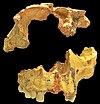
|
ATD6-15 and ATD6-69
(Niño de la Gran Dolina 342) |
0.900[59] | Homo antecessor or Homo erectus |
1994 | Spain | Bermúdez & Arsuaga | Museo de la Evolución Humana , Burgos (Spain)
|
| 0.850±0.150 | Homo erectus | 1891 | Indonesia | Eugène Dubois | Naturalis Biodiversity Center, Leiden | ||

|
Ternifine 2-3 now Tighennif[61] | 0.70 | Homo erectus | 1954 | Algeria | C. Arambourg & B. Hoffstetter | |

|
Sangiran 17[62] | 0.70 | Homo erectus | 1969 | Indonesia | S. Sartono | |

|
Peking Man | 0.73±0.50[63] | Homo erectus | 1921 | China | Davidson Black | Lost/stolen |
| Nanjing Man | 0.60±0.02 | Homo erectus | 1993 | China | Liu Luhong | ||
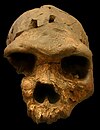
|
Bodo[64]
|
0.600 | Homo heidelbergensis or Homo erectus |
1976 | Ethiopia | A. Asfaw | |
| Benjamina[65][66] | 0.53 | Homo neanderthalensis[67]
|
2001-2001 | Spain | Ana Gracia Téllez | ||

|
Mauer 1 (Heidelberg Man) |
0.50 | Homo heidelbergensis | 1907 | Germany | Daniel Hartmann | Heidelberg University |

|
Saldanha man[68] | 0.50 | Homo rhodesiensis | 1953 | South Africa | ||
| Boxgrove Man | 0.50[69] | Homo heidelbergensis | 1994 | UK
|
Natural History Museum | ||

|
Arago 21
(Tautavel Man) |
0.45 | Homo erectus | 1971 | France | Henry de Lumley | |

|
Ceprano Man[70][71] | 0.450±0.050 | Homo cepranensis
/Homo heidelbergensis |
1994 | Ceprano, Italy | Italo Biddittu | Servizio di antropologia, Soprintendenza ai beni culturali, Regione Lazio, Italy |

|
Agamenón[72] | 0.43 | Homo neanderthalensis[67]
|
1997 | Spain | Paleontological teams | Museo de la Evolución Humana , Burgos (Spain)
|

|
Miguelón | 0.40 | Homo neanderthalensis[67]
|
1992 | Spain | Bermúdez, Arsuaga & Carbonell | Museo de la Evolución Humana , Burgos (Spain)
|

|
Aroeira 3 | 0.40 | Homo heidelbergensis | 2014 | Portugal | João Zilhão [de] | Museu Nacional de Arqueologia, Lisbon
|

|
Salé cranium[73][74][75] | 0.40-0.20 | Homo sapiens?[76] | 1971 | Morocco | Quarry worker | |

|
Swanscombe Man[77]
|
0.40 | Homo neanderthalensis
|
1935, 1936, 1955 | UK
|
Alvan T Marston, John J Wymer and Adrian Gibson | Natural History Museum |

|
Ndutu[78][79] | 0.45±.04 | Homo neanderthalensis affinities
|
1973 | Tanzania | A.A. Mturi | |
| 0.412±0.025[82] | Homo erectus | 1980-1981[83] | Hexian, China
|
||||

|
Gawis cranium | 0.350±0.150 | Homo sapiens
|
2006 | Ethiopia | Asahmed Humet | |

|
Steinheim Skull | 0.35 | Homo heidelbergensis | 1933 | Germany | ||
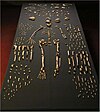
|
Dinaledi Chamber hominins | 0.325±0.090[84] | Homo naledi | 2013 | South Africa | Rick Hunter and Steven Tucker | University of the Witwatersrand (South Africa) |

|
Homo heidelbergensis | 1949 | France | Musée de l'Homme | |||

|
BH-1 | 0.4[85] | Homo heidelbergensis | Mala Balanica, Serbia |
Middle Paleolithic: 300,000–50,000 years old
Upper Paleolithic: 50,000–11,500 years old
| Name | Age (ka) | Species | Date discovered |
Country | Discovered by | Now located at | |
|---|---|---|---|---|---|---|---|

|
Homo luzonensis | 50±10 | Homo luzonensis | 2007 | Philippines | Florent Détroit & Armand Mijares | |

|
Mungo Man
|
50±10 | Homo sapiens
|
1974 | Australia | ||

|
Mt. Circeo 1[136] | 50±10 | Homo neanderthalensis | 1939 | Italy | Prof. Blanc | |
| SID-00B | 49.2±2.5[137] | Homo neanderthalensis | 1994 | Sidrón Cave, Spain | |||
 |
Simanya Neanderthals[138] | 49-42 | Homo neanderthalensis | 1978-1979, 2022 | Simanya cave | Miguel Aznar | Archaeology Museum of Catalonia |
| Ust'-Ishim man | 45 | Homo sapiens | 2008 | Russia | Nikolai Peristov | ||
| Kents Cavern 4 maxilla | 43.5±2.5 | Homo sapiens | 1927 | UK
|
|||
| Zlatý kůň woman | 43 | Homo sapiens | 1950 | Czech Republic | |||
| Tianyuan man | 40.5±1.5 | Homo sapiens | 2007 | China | |||

|
Amud 1[139] | 41[140] | Homo neanderthalensis | 1961 | Israel | Hisashi Suzuki | |

|
Neanderthal 1[141] | 40 | Homo neanderthalensis | 1856 | Germany | Johann Carl Fuhlrott | |

|
Denisova hominin (X-Woman) | 40 | Homo sp. Altai | 2008 | Russia | Johannes Krause, et al. | |

|
hominin toe bone
|
40 | Homo sp. Altai (possible Neanderthal–Denisovan hybrid) | 2010 | Russia | ||
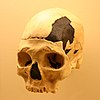
|
Oase 1
|
42–37[142] | EEMH x Neanderthal hybrid)
|
2002 | Romania | ||
Kostenki-14 (Markina Gora)
|
40–37[143] | EEMH )
|
1954 | Russia | |||
| SID-20[144] | 37.30±0.83[137] | Homo neanderthalensis | 1994 | Sidrón Cave, Spain | |||
| Balangoda Man | 37 | Homo sapiens
|
2012 | Sri Lanka | |||

|
Hofmeyr Skull | 36 | Homo sapiens
|
1952 | South Africa | ||

|
Wadjak 1[145]
|
33±4.5[146] | proto-Australoid[147] )
|
1888 | Indonesia | ||

|
Red Lady of Paviland | 33 | Homo sapiens
|
1823 | UK
|
William Buckland | |
| Yamashita-Cho Man | 32 | Homo sapiens
|
1962 | Japan | |||

|
Engis 2 | 40±10[115][148] | Homo neanderthalensis | 1829 | Belgium | Philippe-Charles Schmerling | |

|
Gibraltar 1 | 40±10[115] | Homo neanderthalensis | 1848 | Gibraltar | Captain Edmund Flint | |

|
Le Moustier | 40±10 | Homo neanderthalensis | 1909 | France | ||

|
Denisovan tooth
|
40±10 | Homo sp. Altai | 2000 | Russia | ||
| PES-2 | 38.9–92 | Uncertain, possibly Homo neanderthalensis
|
Serbia | ||||
| PES-1[149] | 31–29 | Uncertain, possibly Homo sapiens
|
Serbia | ||||
Yana RHS
|
31.63 | Homo sapiens
|
Russia | ||||

|
Sungir I | 30.25±0.25 | Homo sapiens
|
Russia | |||
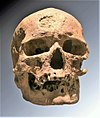
|
Cro-Magnon 1
|
30 | EEMH )
|
1868 | France | Louis Lartet | |

|
WLH-50 | 29±5 | Homo sapiens
|
1982 | Australia | ||

|
Predmost 3[150]
|
26 | Homo sapiens | 1894 | Czech Republic | Karel Jaroslav Maška | |
Lapedo Child
|
24.5 | Homo neanderthalensis or Homo sapiens |
1998 | Portugal | João Zilhão | ||
| Mid-Upper Paleolithoic human humerus from Eel Point, Caldey Island, Wales, UK[151] | 24 | Homo sapiens
|
1997 | UK
|
|||

|
MA-1 (Mal'ta boy)
|
24 | Homo sapiens (ANE )
|
1920s | Russia | ||

|
Abri Pataud Woman | 20.6 | Homo sapiens
|
France | |||
 [152] [152]
|
Minatogawa 1 | 17±1 | Homo sapiens | 1970 | Japan | Anthropology Museum, Tokyo University | |
| Tandou[153][154] | 17 | Homo sapiens | 1967 | Australia | Duncan Merrilees | ||

|
Gough's Cave[155][156] | 14.7 | Homo sapiens | 2010 | UK
|
||

|
Iwo Eleru skull
|
13[157] | Homo sapiens
|
1965 | Nigeria | ||
| "Kotias"[158] | 13 | CHG )
|
Kotias Klde cave, Georgia | ||||
| Arlington Springs Man | 13[159] | Homo sapiens
|
1959 | United States | Phil Orr | ||

|
Chancelade find | 14.5±2.5[160] | Homo sapiens
|
1888 | France | ||

|
Villabruna 1
|
14 | WHG )
|
1988 | Italy | ||
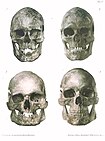
|
Bonn-Oberkassel double burial[161]
|
14-13[161] | Homo sapiens
|
1914[162] | Germany | ||
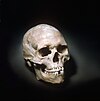 |
Bichon man
|
13.7 | WHG )
|
1956 | Switzerland | ||
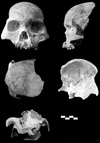 |
Red Deer Cave | 13±1.5 | Homo sapiens
|
1979 | China | Darren Curnoe? |
Holocene (11,500–5,000 years old)
| Name | Age (ka) | Culture / association |
Year discovered |
Country | |
|---|---|---|---|---|---|

|
Luzia | 11.5[163] | Paleo-Indian
|
1975 | Brazil |
| [164] | Cerro Sota 2[165] | 11 | 1936 | Chile | |
| "Satsurblia" | 10 | CHG)[158]
|
Georgia | ||

|
Yaho skull[166]
|
10? | 1961 | Chad | |

|
Kow Swamp 1 | 13–9 | 1968 | Australia | |

|
Talgai Skull[167] | 10±1 | 1886 | Australia | |

|
La Brea Woman | 10 (8000 BC) | Paleo-Indian
|
1914 | United States |

|
Combe Capelle
|
9.6 (7600 BC)[168] | European Mesolithic
|
1909 | France |
| Asselar man | Between 9500 BP and 7000 BP, with caution, 6390 BP[169] | Neolithic | 1927 | Mali | |
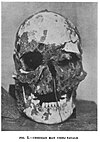
|
Cheddar Man | 9 (7000 BC) | British Mesolithic
|
1903 | UK
|
| Kennewick Man | 9 (7000 BC) | Archaic period (North America) | 1996 | United States | |

|
Barum Woman | 8.8 (6800 BC) | European Mesolithic
|
1939 | Sweden |

|
Tepexpan man | 8±3 | Paleo-Indian
|
1947 | Mexico |

|
Loschbour man[170] | 8 (6000 BC) | WHG )
|
1935 | Luxembourg |

|
Minnesota Woman | 7.9±0.1 (5900 BC) | Paleo-Indian
|
1931 | Minnesota, United States |
| Lothagam 4b (Lo 4b)[171] | 7.5±1.5[172] | 1965–1975 | Kenya | ||

|
Bessé’[173]
|
7.3–7.2 | Toalean | 2015 | Sulawesi, Indonesia |

|
Ötzi | 5.3 (3230 BC) | European Neolithic
|
1991 | Ötztal Alps, Italy |
Abbreviations used in fossil catalog name
- AL – Afar Locality, Ethiopia
- ARA-VP – Aramis Vertebrate Paleontology, Ethiopia
- BAR – (Lukeino, Tugen Hills) Baringo District, Kenya
- BOU-VP – Bouri Vertebrate Paleontology, Ethiopia
- D – Dmanisi, Georgia
- ER – East (Lake) Rudolf, Kenya
- KGA – Konso-Gardula, Ethiopia
- KNM – Kenya National Museum
- KP – Kanapoi, Kenya
- LB – Liang Bua, Indonesia
- LH – Laetoli Hominid 4, Tanzania
- MH – Malapa Hominin, South Africa
- NG – Ngandong, Indonesia
- OH – Olduvai Hominid, Tanzania
- SK – Swartkrans, South Africa
- Sts, Stw – Sterkfontein, South Africa
- TM – Transvaal Museum, South Africa
- TM – Toros-Menalla, Chad
- WT – West (Lake) Turkana, Kenya
See also
Further reading
- Gibbons, Ann. The First Human: The Race to Discover our Earliest Ancestor. Anchor Books (2007). ISBN 978-1-4000-7696-3
- Hartwig, Walter Carl (2004) [2002]. ISBN 978-0-521-08141-2..
- ISBN 978-0-307-39640-2
- ISBN 978-0-521-46786-5. (Note: this book contains very useful, information dense chapters on primate evolution in general, and human evolution in particular, including fossil history).
- ISBN 0-316-90298-5
- ISBN 0-14-022638-9
- Morwood, Mike & van Oosterzee, Penny. A New Human: The Startling Discovery and Strange Story of the 'Hobbits' of Flores, Indonesia. Smithsonian Books (2007). ISBN 978-0-06-089908-0
- ISBN 1-84119-697-5
- ISBN 978-0-7475-9839-8
- Shreeve, James. The Neanderthal Enigma: Solving the Mystery of Modern Human Origins. Viking (1996). ISBN 0-670-86638-5
- ISBN 978-1-84614-140-9
- ISBN 0-500-05132-1
- ISBN 0-224-03771-4
- van Oosterzee, Penny. The Story of Peking Man. Allen & Unwin (1999). ISBN 1-86508-632-0
- ISBN 0-297-81670-5
- ISBN 978-0-7156-3658-9
- Weiss, M.L.; Mann, A.E. (1985). 'Human Biology and Behaviour: An anthropological perspective (4th ed.). Boston: Little Brown. ISBN 978-0-673-39013-4. (Note: this book contains very accessible descriptions of human and non-human primates, their evolution, and fossil history).
- Wells, Spencer (2004). The Journey of Man : A Genetic Odyssey. New York: Random House Trade Paperbacks. ISBN 978-0-8129-7146-0.
References
- S2CID 20189444.
- PMID 28531170.
- S2CID 1316969.
- ^ "Bar 10200'". Smithsonian National Museum of Natural History. 2010-01-23. Retrieved 2012-07-27.
- PMID 34635686.
- ^ "Ardipithecus kadabba". efossils. Retrieved 26 March 2015.
- ^ Amos, Jonathan (2009-10-01). "Fossil finds extend human story". BBC News.
- doi:10.4207/PA.2015.ART94 (inactive 31 January 2024).)
{{cite journal}}: CS1 maint: DOI inactive as of January 2024 (link - S2CID 128952193.
- ^ Bernard Wood, Wiley-Blackwell Encyclopedia of Human Evolution (2011), 887.
- ^ .
- S2CID 4185736.
- ^ Lothagam mandible fragment Archived 2011-07-16 at the Wayback Machine
- PMID 3103460.
- ^ Heslip, Steven (2001). "Australopithecus anamensis". Archived from the original on June 8, 2011.[self-published source?]
- ^ "Oldupai". Ntz.info. Retrieved 2012-10-15.
- PMID 9924134
- ^ Anthropology, The University of Texas at Austin, Department of. "Kenyanthropus platyops: KNM WT 40000". www.efossils.org.
{{cite web}}: CS1 maint: multiple names: authors list (link) - ^ "KNM-WT 40000". 23 January 2010.
- ^ "New human ancestor species from Ethiopia lived alongside Lucy's species". www.sciencedaily.com. 27 May 2015. Retrieved 2015-05-28.
- ^ http://www.modernhumanorigins.net/al444-2.html Archived 2010-08-29 at the Wayback Machine Image at Modern Human Origins
- ^ http://www.eurekalert.org/multimedia/pub/87535.php Archived 2020-06-04 at the Wayback Machine Image at Eurekalert
- ^
Villmoare, Brian; Kimbel, William H.; Seyoum, Chalachew; Campisano, Christopher J.; DiMaggio, Erin N.; Rowan, John; Braun, David R.; Arrowsmith, J. Ramón; PMID 25739410.: "The Gurumaha Tuff is radiometrically dated to 2.842±0.007 Ma, a date that is consistent with the normal magnetic polarity of the Gurumaha section, presumably the Gauss Chron. An upper bounding age for LD 350-1 is provided by an adjacent, downfaulted younger block that contains the 2.665±0.016 Ma Lee Adoyta Tuff. [...] the age of LD 350-1 can be further constrained by stratigraphic scaling. [...] Based on the current chronostratigraphic framework for Ledi-Geraru, we consider the age of LD 350-1 to be 2.80–2.75 Ma".
- ^ Bouri Vertebrate Paleontology "Australopithecus garhi: BOU-VP-12/130". efossils. Retrieved 13 June 2016.
- ^ http://humanorigins.si.edu/evidence/human-fossils/fossils/sts-71 Image at Smithsonian
- doi:10.1016/S1251-8050(97)88294-8.. Since the discovery of LD 350-1(2.8 Ma, intermediate between Australopithecus and Homo) arguably demoted to the rank of second-oldest fossil of Homo.
- ^ "STS 14". Archived from the original on 2006-01-18. Retrieved 2006-07-11. Image at Modern Human Origins. "Australopithecus africanus". Australian Museum. 20 January 2011.
- ^ PMID 21392817.
- ^ S2CID 214763272.
- S2CID 226296091.
- ^ "Modernhumanorigins.net". www.modernhumanorigins.net. Archived from the original on 2010-06-17. Retrieved 2007-03-18.
- ^ Department of Anthropology: The University of Texas at Austin. "Paranthropus robustus: TM 1517". Retrieved 2014-06-09.
- ^ "Spectacular South African Skeletons Reveal New Species from Murky Period of Human Evolution". Scientific American. Archived from the original on 2013-11-11.
- ^ Juliet King (June 4, 2010). "Australopithecus sediba fossil named by 17-year-old Johannesburg student". Origins Centre. Archived from the original on March 25, 2012. Retrieved 2011-07-09.
- ^ Amos, Jonathan (2011-09-08). "African fossils put new spin on human origins story". BBC News. Retrieved 9 September 2011.
- ^ Mai, L.L., Owl, M.Y., & Kersting, M.P. (2005), p. 286
- ^ "SK 46". 24 January 2010.
- ^ "Modernhumanorigins.net". www.modernhumanorigins.net. Archived from the original on 2007-09-27. Retrieved 2007-03-18.
- ^ http://humanorigins.si.edu/evidence/3d-collection/oh-24 Archived 2016-03-04 at the Wayback Machine Image at Smithsonian
- ^ http://www.modernhumanorigins.net/oh8.html Archived 2010-12-08 at the Wayback Machine OH 8 image of foot at Modern Human Origins
- S2CID 20435482.
- S2CID 4431262.F
- ^ Inverted strata Archived 2006-10-02 at the Wayback Machine
- ^ Donald C. Johanson; Blake Edgar (1996). From Lucy to Language. New York: Simon & Schuster. p. 158.
- ^ "Image at Smithsonian". Archived from the original on 2016-03-07. Retrieved 2013-02-08.
- PMID 3136654.
- ISBN 978-0202365961. Retrieved 16 February 2015.
- ^ .
- .. "paleo-magnetic results of this study delimit the age of KNM-ER 3733 to 1.78–1.48 Ma, making it one of the most securely dated fossils of early African H. erectus when compared to the oldest Homo fossils from Europe and Asia."
- PMID 23481345.
- PMID 18046746.
- ^ Smithsonian National Museum of Natural History (2010-01-24). "Konso KGA10-525". What does it mean to be human?. Retrieved 17 February 2015.
- ^ "Modernhumanorigins.net". www.modernhumanorigins.net. Archived from the original on 2010-06-17. Retrieved 2007-03-17.
- ^ a b "Atapuerca completa el puzle con el "Homo erectus": "Es seguro, no hay dudas"". www.larazon.es (in Spanish). 2023-01-29. Retrieved 2023-08-13.
- .
- .
- PMID 18067194.
- ^ "New Skull from Eritrea – Archaeology Magazine Archive". archive.archaeology.org.
- .
- ^ "Trinil 2". 24 January 2010.
- ^ "Ternifine or Tighenif". Archived from the original on 11 July 2014. Retrieved 28 March 2015.
- ^ "Modernhumanorigins.net". www.modernhumanorigins.net. Archived from the original on 2010-01-06. Retrieved 2007-03-17.
- S2CID 19264385.
- ^ "Modernhumanorigins.net". www.modernhumanorigins.net. Archived from the original on 2010-01-06. Retrieved 2007-03-17.
- ^ Romero, Lorena Sánchez (2020-11-27). "Prehistoria - Benjamina, la niña pre neandertal más querida de Atapuerca". Quo (in Spanish). Retrieved 2023-08-24.
- S2CID 33720448.
- ^ S2CID 205826399.
- ISBN 978-0471326441..
- PMID 11312585.
- ^ Di Vincenzo, Fabio; Bernardini, Federico; Manzi, Giorgio. "The Ceprano calvarium, twenty years after. A new generation of (digital) studies". ResearchGate. Retrieved 26 October 2017.
- ^ Fraioli, Luca. "Dopo 400mila anni, ecco il vero volto dell'Uomo di Ceprano". Retrieved 26 October 2017.
- ^ ""Agamenón", el homínido más famoso de Atapuerca, no estaba sordo". historia.nationalgeographic.com.es (in Spanish). 2019-10-11. Retrieved 2023-08-23.
- ISBN 978-1135582289. Retrieved 9 August 2015.
- ^ Smithsonian National Museum of Natural History (2010-01-30). "Salé". What does it mean to be human?. Retrieved 18 May 2014.
- ISBN 978-9027976291.)
{{cite book}}: CS1 maint: location missing publisher (link - ISBN 978-94-007-2929-2, retrieved 2023-08-13
- ^ Natural History Museum Neanderthal woman in pieces Retrieved 16 May 2018
- ^ http://humanorigins.si.edu/evidence/3d-collection/ndutu Archived 2016-03-04 at the Wayback Machine Image at Smithsonian
- ISSN 2571-9408.
- ^ Peter Brown. "Hexian". Peter Brown's Australian & Asian Palaeoanthropology. Retrieved 2014-05-18.
- ^ http://www.modernhumanorigins.net/pa830.html Archived 2013-06-06 at the Wayback Machine Hexian PA830 image at Modern Human Origins
- PMID 9650100.
- ^ Maolin, Wu (1983). "Homo erectus from Hexian, Anhui found in 1981". Acta Anthropologica Sinica. 2 (2): 109–205.
- PMID 28483040.
- PMID 27086056.
- ^ Grün, R., Pike, A., McDermott, F., Eggins, S., Mortimer, G., Aubert, M., ... & Brink, J. (2020). Dating the skull from Broken Hill, Zambia, and its position in human evolution. Nature, 580(7803), 372-375.
- S2CID 205255853. "Here we report the ages, determined by thermoluminescence dating, of fire-heated flint artefacts obtained from new excavations at the Middle Stone Age site of Jebel Irhoud, Morocco, which are directly associated with newly discovered remains of H. sapiens8. A weighted average age places these Middle Stone Age artefacts and fossils at 315±34 thousand years ago. Support is obtained through the recalculated uranium series with electron spin resonance date of 286±32 thousand years ago for a tooth from the Irhoud 3 hominin mandible."; Smith TM, Tafforeau P, Reid DJ, et al. (April 2007). "Earliest evidence of modern human life history in North African early Homo sapiens". Proceedings of the National Academy of Sciences of the United States of America. 104 (15): 6128–33.PMID 17372199.
- ISSN 1804-6665.
- ^ http://www.modernhumanorigins.net/dali.html Archived 2010-08-28 at the Wayback Machine Dali image at Modern Human Origins
- . "correlating the pIRIR290 ages between 267.7±13.9 ka and 258.3±14.2 ka and new pollen analysis, we proposed a new viewpoint that the Dali Man was likely to live during a transitional period from glacial to interglacial climate in the S2/L3 (MIS 7/8) stage."
- PMID 22040649.
- ^ ISSN 1000-3193.
- ^ "Ariadne portal". portal.ariadne-infrastructure.eu. Retrieved 2024-01-29.
- PMID 29337994.
- ^ "Italy's first Neanderthal dates back 250,000 years". 4 November 2015.
- PMID 18178238.
- ^ S2CID 195873640.
- ^ a b Signals of Evolution in the Territory of Greece. Paleoanthropological Findings. Christos Valsamis. Intensive Course in Biological Anthropology. 1st Summer School of the European Anthropological Association. 16–30 June 2007, Prague, Czech Republic.
- S2CID 4359695.
- PMID 35022610.
- ^ "Modernhumanorigins.net". www.modernhumanorigins.net. Archived from the original on 2010-08-18. Retrieved 2007-03-17.
- ISSN 2042-5937. Rajendran, P.; Bharath Kumar, R.; Bhanu, Vijaya (2003). "Fossilized hominid baby skull from the ferricrete at Odai, Bommayarpalayam, Villupuram District, Tamil Nadu, South India" (PDF). Current Science. 84 (6): 754. Archived from the original (PDF) on 2016-03-03. Retrieved 2019-09-25. "A similar type of ferricrete on Kerala coast has been dated by electron spin resonance to 0.187 million years. Therefore, more or less the same age can be assigned to the ferricrete at Odai and to the infant baby skull found within it. In the hominid evolutionary stage this may belong to the Homo erectus or Homo sapiens (Archaic)"
- PMID 29371468.
- Eemian or to the LGM. Chang, Chun-Hsiang; Kaifu, Yousuke; Takai, Masanaru; Kono, Reiko T.; Grün, Rainer; Matsu'ura, Shuji; Kinsley, Les; Lin, Liang-Kong (2015). "The first archaic Homo from Taiwan".PMID 25625212.
- ISBN 978-1-893882-19-5.
- PMID 25625212.
- ^ Choi, Charles Q. (January 27, 2015). "Ancient Human Fossil Could Be New Primitive Species". Live Science.
- ^ "News in Science – Missing link in human evolution found in Africa". www.abc.net.au. December 6, 2003.
- S2CID 141503768.
- S2CID 23113153. Archived from the original(PDF) on 2020-03-17. Retrieved 2019-09-26.
- .
- ^ http://www.modernhumanorigins.net/tabun1.html Archived 2013-08-16 at the Wayback Machine Tabun 1 Image at Modern Human Origins
- PMID 11437523.
- ^ "Krapina C Images at Modern Human Origins". Archived from the original on 2007-09-27. Retrieved 2007-03-20.
- ^ PMID 21078988.
- ^ "Researchers determine age for last known settlement by a direct ancestor to modern humans". Nature.
- New York Times. Retrieved 16 November 2015.
- PMID 26630009.
- ^ "Modernhumanorigins.net". www.modernhumanorigins.net. Archived from the original on 2010-07-18. Retrieved 2007-03-18.
- S2CID 237469414.
- S2CID 198953011.
- ^ "Modernhumanorigins.net". www.modernhumanorigins.net. Archived from the original on 2010-06-10. Retrieved 2007-03-17.
- PMID 30135540.
- S2CID 188160693. Retrieved 22 August 2018.
- ^ Marshall, Michael (22 August 2018). "Prehistoric girl had parents belonging to different human species". New Scientist. Retrieved 22 August 2018.
- S2CID 233871256.
- ISBN 978-90-481-9093-5.
- ^ "What does it mean to be human?". Smithsonian National Museum of Natural History. 2010-02-27. Archived from the original on 2021-03-05. Retrieved July 27, 2012.
- ^ PMID 18479734.
- ^ "La Quina 5". National Museum of Natural History. Smithsonian Institution. 30 August 2022. Retrieved 18 November 2023.
- ISBN 978-0-7432-8064-8.
- ^ "Modernhumanorigins.net". www.modernhumanorigins.net. Archived from the original on 2011-07-16. Retrieved 2007-03-18.
- S2CID 4386123.
- ^ PMID 22908291.
- PMID 25849125.
- ^ "Modernhumanorigins.net". www.modernhumanorigins.net. Archived from the original on 2011-05-30. Retrieved 2007-03-18.
- ^ S2CID 140163071.
- ISSN 2296-6463.
- ^ http://www.modernhumanorigins.net/amud1.html Archived 2011-04-24 at the Wayback Machine Amud 1 Image at Modern Human Origins
- ^ "Human evolution: interpreting evidence". Museum of Science, Boston, US. Archived from the original on May 2, 2004. Retrieved July 27, 2012.
- ^ "Modernhumanorigins.net". www.modernhumanorigins.net. Archived from the original on 2010-06-20. Retrieved 2007-03-18.
- PMID 26098372.
- ^ Синицын, А. А., Исследование памятников древнейшего этапа верхнего палеолита Восточной Европы. Раскопки стоянки Костенки-14 (Маркина Гора), Институт истории материальной культуры РАН, 2004.
Seguin-Orlando, A. (2014). "Genomic structure in Europeans dating back at least 36,200 years". Science. 346 (6213): 1113–1118. S2CID 206632421.
- ^ canadianarchaeology.ca
- JSTOR 40386932.
- ^ Wadjak 1 and Wadjak 2 are fossil human skulls discovered near Wajak, a town in Malang Regency, East Java, Indonesia in 1888/90.
Dubbed "Wajak Man", and formerly classified as a separate species (Homo wadjakensis), the skulls are now recognized as early anatomically modern human. They were dated to the Holocene, 12 to 5 ka, in the 1990s, but this has been revised in a 2013 study which claimed a far earlier date, "a minimum age of between 37.4 and 28.5 ka".
Storm, Paul; Wood, Rachel; Stringer, Chris; Bartsiokas, Antonis; de Vos, John; Aubert, Maxime; Kinsley, Les; Grün, Rainer (2013). "U-series and radiocarbon analyses of human and faunal remains from Wajak, Indonesia". Journal of Human Evolution. 64 (5): 356–365. PMID 23465338. J. Krigbaum in: Habu et al. (eds), Handbook of East and Southeast Asian Archaeology (2017), p. 314.
- ^ Peter Bellwood, Prehistory of the Indo-Malaysian Archipelago: Revised Edition (2007), 86ff.
- ^ adams, fran. "Descriptions of Fossil Neandertals". www.boneandstone.com.
- S2CID 213503541.
- ^ "Modernhumanorigins.net". www.modernhumanorigins.net. Archived from the original on 2013-06-06. Retrieved 2007-03-18.
- PMID 15857652.
- ^ "Modernhumanorigins.net". www.modernhumanorigins.net. Archived from the original on 2013-08-16. Retrieved 2007-03-18.
- JSTOR 40386634.
- ^ "Lake Tandou Skull". Australia: The Land Where Time Began. Retrieved 2014-05-19.
- ^ Stringer, C. B. (1985). "The hominid remains from Gough's Cave" (PDF). Proceedings of the University of Bristol Spelaeological Society. 17 (2): 145–52. Archived from the original (PDF) on 2013-11-10. Retrieved 2011-05-22.
- ^ McKie, Robin (June 20, 2010). "Bones from a Cheddar Gorge cave show that cannibalism helped Britain's earliest settlers survive the ice age". The Observer. Guardian. Retrieved 2012-10-15.
- ^ "Mystery of a West African skull from 13,000 years ago". Natural History Museum, London. Archived from the original on 2012-08-02. Retrieved July 27, 2012.
- ^ PMID 26567969. "We sequenced a Late Upper Palaeolithic ('Satsurblia' from Satsurblia cave, 1.4-fold coverage) and a Mesolithic genome ('Kotias' from Kotias Klde cave, 15.4-fold) from Western Georgia, at the very eastern boundary of Europe. We term these two individuals Caucasus hunter-gatherers (CHG)."
- ^ Johnson, John. "Arlington Man". National Park Service. Retrieved December 25, 2014.
- ISBN 978-2-03-075437-5.)
{{cite book}}: CS1 maint: multiple names: authors list (link - ^ PMID 29376123.
- ^ VERWORN, Max (1919). Der Diluviale Menschenfund Von Obercassel Bei Bonn. Bearbeitet M. Verworn, R. Bonnet und G. Steinmann, Etc (in German).
- Discovery Communications Inc. Archived from the originalon December 24, 2007. Retrieved July 2, 2014.
- ISBN 978-1-58729-014-5.
- ISBN 978-1587290145. Retrieved August 21, 2013.
- S2CID 143549941.
- ISSN 2047-6930.
- ^ Seidler, Christoph (9 February 2011). "Forscher entzaubern Steinzeitmann". Der Spiegel (in German). Retrieved 2012-04-19.
- ^ Vialet, Amélie; André, Lucile; Aoudia, Louiza. [https%3A%2F%2Fcoek.info%2Fpdf-lhomme-fossile-dasselar-actuel-mali-etude-critique-mise-en-perspective-historiqu.html "The Fossil Man from Asselar (present-day Mali). Critical study, historical perspective and new interpretations"]. Kundoc. Anthropology.
{{cite web}}: Check|url=value (help) - PMID 25230663..
- ^ Angel, J.L.; Phenice, T.W.; Robbins, L.H.; Lynch, B.M. (1980). Late stone age fishermen of Lothagam, Kenya. National Anthropological Archives, Sithsonian Institution, Part 3.
- ^ Lo 4b is the best preserved skull out of a sample of 30 fully modern skeletons of the period 9–6 ka, found at Lothagam, West Turkana, Kenya, excavated between 1965 and 1975. Joseph F. Powell, The First Americans (2005), 169.
- PMID 34433944.
Bibliography
- Tattersall, Ian; Schwartz, Jeffery (2000). Extinct Humans. Boulder CO: Westview Press. ISBN 978-0-8133-3482-0.
- Larsen, Clark Spencer; Matter, Robert M; Gebo, Daniel L (1991). Human Origins: the fossil record. Waveland Press, Prospect Heights, IL. ISBN 978-0-88133-575-0.
- "Smithsonian Human Origins Program". Retrieved 2006-08-29.
- "Prominent Hominid Fossils". Retrieved 2006-08-31.
- Grine, F.E.; Jungers, W.L.; Schultz, J. (1996). "Phenetic Affinities Among Early Homo Crania from East and South Africa". Journal of Human Evolution. 30 (3): 189–225. .
External links
- Interactive map of primate fossil finds around the world Archived 2012-02-22 at the Wayback Machine
- Informative lecture on Australopithecines
- The Age of Homo sapiens – Interactive Map of Human Evolution Fossils
- Human Timeline (Interactive) – Smithsonian, National Museum of Natural History (August 2016).







